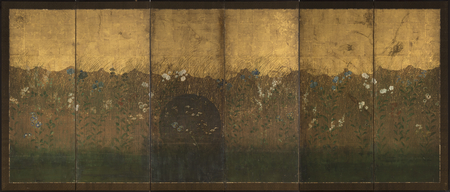Product Description
7842 A six-fold paper screen painted in ink and colour on a gold ground with the scene of the Plains at Musashino where the silver moon is rising amongst hagi (bush clover), kikyō (bellflower), nogiku (asteroideae), nadeshiko (fringed pinks) and other autumnal grasses
Japan 17th century Edo period
Dimensions: H. 120cm x W. 279cm (47¼” x 109¾”)
In the realm of meisho-e (pictures of famous scenic places), the portrayal of a large full moon or sun viewed through autumnal grasses represents Musashino (the Musashi plain).
The plain of Musashi was a large flat expanse of land west of Edo, most famous for the illusion of the moon rising straight out of the grasses and similarly the sun appeared at its largest size and deepest shade of red just before setting into the horizon.
A poem celebrating this famous landscape was written by the aristocrat Minamoto Michikata (1189–1238) and is included as no.425 in the imperial poetry anthology of c.1265, the Shokukokin Wakashu (Collection of Ancient and Modern Poems Continued).
Musashino wa
tsuki no irubeki
mine mo nashi
obana ga sue ni
kakaru shirakumo
On the Musashi plain
there is no peak
for the moon to enter
white clouds catch in
the tips of the flowers.
This famous location also appears in Chapter 12 of the 10th century novel Ise Monogatari (Tales of Ise) where a young couple elope and hide amongst the tall grasses of Musashino. When their pursuers threaten to set fire on the grasses the lady pleads for mercy with the waka poem that reads:
Musashino wa
kyō wa na yaki so
Wakakusa no
tsuma mo komoeri
ware mo komoeri
Oh no, please, today
do not burn the Musashi Plain!
Tender as young grass,
my beloved is hiding here,
and I too am hiding here.
During the Edo period Musashino was frequented by picnickers inspired by its haunting beauty, poetic references and spectacular views of Mount Fuji. After the recent era of industrialisation Musashi lost its original landscape and is currently an area located in the centre of the metropolis of Tokyo.
For other examples of this subject matter in the collection of the Chicago Art Museum see: Japanese Design in Art vol.12 p.32-33, pl.25 and another pair in the collection of the Nezu Museum see: Catalogue of Selective Masterpieces from the Nezu Collections, Painting and Calligraphy, p. 162-163, pl. 138. Also for a further pair of six-fold screens in the collection of Fujita Museum see: Nihon Byōbue Shūsei, vol.9: Shiki Keibutsu (Natural Features of Four Seasons), p. 84-87, no.70-75, 77-78, 80.









